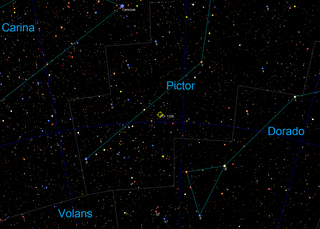TOI 1338
 Position of TOI 1338 in Pictor | |
| Observation data Epoch J2000 Equinox J2000 | |
|---|---|
| Constellation | Pictor |
| Right ascension | 06h 08m 31.94s.[1] |
| Declination | −59° 32′ 27.55″.[1] |
| Apparent magnitude (V) | 11.72[2] |
| Characteristics | |
| Spectral type | F8[3] |
| Variable type | eclipsing[3] |
| Astrometry | |
| Radial velocity (Rv) | 24.68±8.08[4] km/s |
| Proper motion (μ) | RA: −12.258±0.037[4] mas/yr Dec.: 34.405±0.041[4] mas/yr |
| Parallax (π) | 2.4774 ± 0.0196[4] mas |
| Distance | 1,320 ± 10 ly (404 ± 3 pc) |
| Orbit[2] | |
| Period (P) | 14.608559+0.00013 −0.00012 d |
| Semi-major axis (a) | 0.1321+0.0024 −0.0025 AU |
| Eccentricity (e) | 0.15603±0.00015 |
| Inclination (i) | 89.696+0.178 −0.114° |
| Semi-amplitude (K1) (primary) | 21.619±0.007 km/s |
| Details[2] | |
| TOI 1338 A | |
| Mass | 1.127+0.068 −0.069 M☉ |
| Radius | 1.331+0.024 −0.026 R☉ |
| Luminosity | 2.133[4] L☉ |
| Surface gravity (log g) | 4.0 cgs |
| Temperature | 6,160 K |
| Metallicity [Fe/H] | +0.01 dex |
| Rotation | 19±3 d |
| Rotational velocity (v sin i) | 3.6 km/s |
| Age | 4.4 Gyr |
| TOI 1338 B | |
| Mass | 0.3128+0.0113 −0.0118 M☉ |
| Radius | 0.3089+0.0056 −0.0060 R☉ |
| Other designations | |
TYC 8533-950-1, EBLM J0608-59, 2MASS J06083197-5932280, RAVE J060832.0-593228 | |
| Database references | |
| SIMBAD | data |
| Extrasolar Planets Encyclopaedia | data |
TOI 1338 is a binary star system located in the constellation Pictor, about 1,320 light-years from Earth.[2] It was discovered by the Transiting Exoplanet Survey Satellite (TESS) and is orbited by the circumbinary planet TOI 1338 b.[1][4]
Nomenclature and history[]
The acronym TOI stands for "TESS Objects of Interest." The planet was found by Wolf Cukier, a high school student, who joined the Goddard Space Flight Center as a summer intern. He looked through light curves that were flagged as eclipsing binaries by volunteers of the Planet Hunters citizen science project.[5] Cukier and six of the planet hunter volunteers are co-authors of the publication.[2]
The name "Wolftopia" was suggested by Wolf Cukier's brother. Cukier was not allowed to name the planet.[6]
In February 2021, a petition calling for the planet TOI 1338 b in the system to be named SOPHIE received over 90,000 signatures.[7] Organisers of the petition sought to pay homage to the late Scottish musician and music producer Sophie, who died on 30 January 2021.[8] High-profile supporters of the campaign included Charli XCX and Caroline Polachek.[7]
The stellar binary[]
TOI 1338 is a single-lined spectroscopic binary system, consisting of an F8 star and a red dwarf of spectral type M. The system has an age of 4.4 billion years. The two stars with masses of 1.13 and 0.313 M☉ revolve around each other every 14.6 days. The red dwarf is about nine magnitudes fainter than the primary star and cannot be detected in the spectrum.[9][2]
The orbit of the two stars is inclined at 89.7° and both primary and secondary eclipses can be observed, although the brightness changes are very small. The primary eclipse occurs when the hotter primary star is partially occulted by the cooler secondary. It lasts about five hours and the brightness decreases by about 4%. The secondary eclipses occur when the cooler star is occulted by the hotter star. They also last about five hours but the brightness drops by less than half a percent.[2]
Planetary system[]

The planet (between Neptune and Saturn in size) TOI 1338b has an orbit that is within ~1° coplanar with the binary. This means that the orbit of the binary and the orbit of the planet are on the same plane.[2] The spin of the primary star also aligns with the orbits of the binary and the planet (spin-orbit angle β = 2.8±17.1 °). This is the second time the Rossiter–McLaughlin effect was measured for a star hosting a circumbinary planet. Kepler-16 was the first system with such a measurement. The measurement of the alignment for TOI 1338 suggests that the planet formed from a single circumbinary disk.[10]
| Companion (in order from star) |
Mass | Semimajor axis (AU) |
Orbital period (days) |
Eccentricity | Inclination | Radius |
|---|---|---|---|---|---|---|
| b | 33.0±20.0 M |